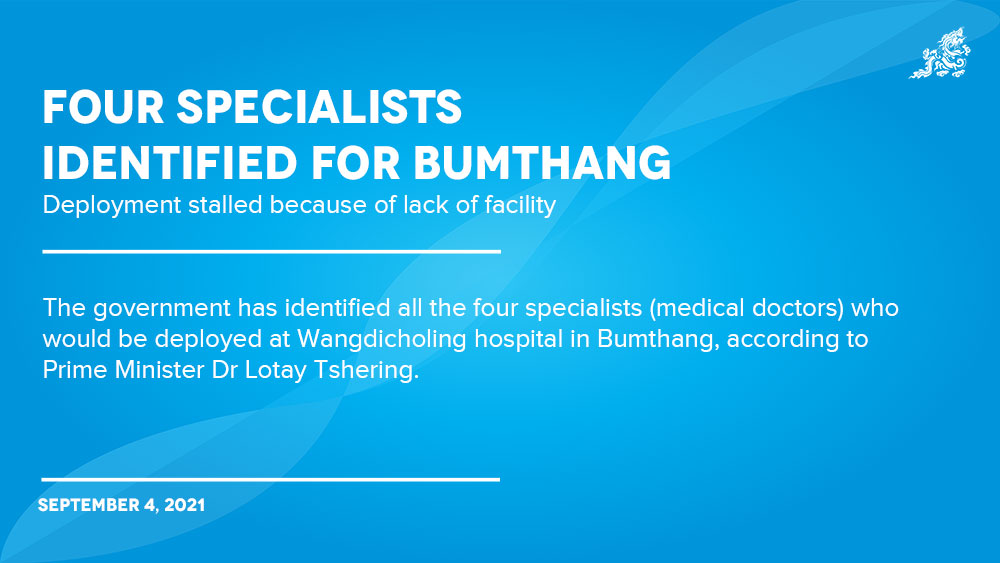Deployment stalled because of lack of facility
Younten Tshedup
The government has identified all the four specialists (medical doctors) who would be deployed at Wangdicholing hospital in Bumthang, according to Prime Minister Dr Lotay Tshering.
The deployment of four specialists was one of the main pledges made by the Druk Nyamrup Tshogpa (DNT) government during the Chhoekhor-Tang bye-elections in November last year, where the DNT candidate Dawa won the elections.
However, the identified specialists — a gynaecologist, a paediatrician, an anaesthesiologist, and a surgeon — are yet to be deployed to the hospital as the existing facility requires some upgradation including the installation of equipment inside the operation theatre.
Lyonchhen said that the ministry was in the process of procuring the required equipment. “As soon as the equipment are installed, the doctors will be deployed.”
He said that the gynaecologist could be deployed anytime now as he or she could conduct cervical cancer treatments including pap smear coverage in the nearby dzongkhags of Zhemgang and Trongsa.
However, many are still questioning if Bumthang requires four specialist doctors given its population size, proximity to the nearest referral point, presence of other institutions, poverty rate, and number of female population between 15 and 49 years among others.
According to the population and housing census of Bhutan 2017, with 17,820 (8,428 female) people, Bumthang has a relatively low population density as compared to other dzongkhags. The poverty rate in Bumthang as per the poverty analysis report 2017 is 2.1 compared to 14.0 for neighbouring Trongsa.
Bumthang was also not identified as one of the emergency obstetric, neonatal, essential surgical and trauma centres by the health ministry.
The identification of these centres was done some three decades ago by the ministry. Today, of the eight centres identified in the late 1980s, only four are functional with at least one specialist.
Trongsa was one of the eight identified centres. The centre was identified to cater services to the central parts of the country including Zhemgang, Bumthang and Trongsa.
If the hospital is established in Bumthang, people of Zhemgang would have to travel almost double the distance.
The caseload (patient attendance), however, at the Wangdicholing hospital is relatively higher than some of its neighbouring dzongkhags. The hospital saw close to 30,000 patients in last year with an average of 82 plus patients every day.
Since 2017, health facilities in Bumthang, including all the basic health units, have attended to 215,304 patients (new and old cases). During the same period, health facilities in Trongsa saw 185,853 patients and 302,406 people visited health facilities in Zhemgang.
But all these numbers do not correspond to using specialist services. Majority of them, according to health officials, are usually general cases.
Health officials say that deploying four specialists at the existing 20-bed Wangdicholing hospital would not be practical as this would mean that hospital would require an expansion to house the specialists including new facilities for the specialists to work, which includes a separate medical, paediatric and gynae wards including additional operation theatres which would be a prerequisite for the new set of specialists.
According to sources, the government was considering expansion of the existing hospital with provision of building new infrastructure. However, officials from the health ministry said that there was no such discussion taken, for now.
Wangdicholing hospital currently has two general duty medical officers.
Meanwhile, expecting mothers from Samdrupjongkhar have to travel to Trashigang, Mongar and Gelephu hospitals as there is no gynaecologist in Samdrupjongkhar and Dewathang hospitals. The gynaecologist in Dewathang was transferred three years ago and the hospital did not receive a replacement.
Many expecting mothers from Samdrupjongkhar told Kuensel that besides the risk of travelling long distances, they also have to stay in quarantine to travel to low-risk areas to avail basic services and for institutional delivery.
Edited by Tashi Dema


